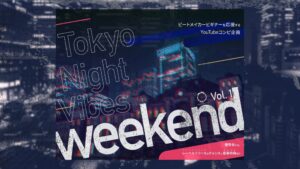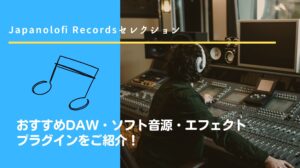ローファイヒップホップやチルホップを愛する外国の方々と会話をしていると、必ず話題に挙がるアーティストの名前がいくつかあります。
J Dillaと並び特に話題に上がることが多いのが、Nujabesではないでしょうか。
海外におけるローファイ、チルミュージックシーンにおいて、J DillaとNujabesは神格化されている存在だと言えます。
ただこのNujabes、現代日本ではあまり知られていないように感じています。彼の国籍すら知らない方もいらっしゃるのではないでしょうか?
果たしてNujabesとはいったいどんな人物なのか?
なぜここまで神格化されるようになったのか?
彼がこのジャンルに与えた影響とは?
ローファイ/チルミュージックを嗜むのなら、Nujabesは必修項目です。今回は、そんなNujabesをわかりやすく紐解いていく内容になっています。
さっそく、解説に入っていきましょう!
Nujabesのプロフィール
まずお伝えしたいのは、Nujabesは日本人であるということです。このミステリアスなアーティストネームから、なんとなく外国人を想像した方も多いでしょう。そんな皆さんは、見事に彼のブランディングの術中にはまっています。
本名、山田 淳(やまだ じゅん)。
とにかく音楽好きな青年で、よくクラブに遊びに行っては、DJに「この曲なんですか?」と頻繁に聞いていたそうです。
そんなことを繰り返していると自然と音楽に対し博識になっていくわけで、彼はその音楽知識の豊富さを活かし、音楽ライターとして雑誌に寄稿するようになります。自身を瀬葉 淳(せば じゅん)と名乗り始めたのはその頃からです。
1995年、彼は21歳の学生でありながら、渋谷にレコードショップ『GUINNESS RECORDS』をオープンしました。数々のレコードを集めながら、1998年についにトラックメイキングをスタート。Nujabesとしての活動が始動します。
Nujabesというアーティストネームが、彼のペンネームである瀬葉 淳の逆さ読みであることは有名な話です。ローマ字表記のSeba Junを逆から並べてみると、Nujabesが出来上がります。
彼の好みはもっぱら、海外音楽でした。なかでも、メロウなソウルミュージック、スピリチュアルなジャズが好きだったようです。
折しも、当時の日本で特に盛り上がりを見せていたのはヒップホップでした。Nujabesも、その特有のビート感にも興味を持っていました。
彼が好んでいたスムースソウルやスピリチュアルジャズと、ヒップホップのビート感。これらが合わさるような形で、彼の音楽性は形作られていったのです。そんな彼の音楽は、『ジャジー・ヒップホップ』として日本で流行し、一大ブームを築き上げるほどになります。
Nujabesとはこんなアーティスト!
秀逸なブランディングで根強いファンを獲得
Nujabesは持ち前の行動力から、1999年に自らが主宰を務めるレーベル『Hydeout Productions』を立ち上げます。運営初期は日本のレーベルであることは意図的に伏せていたので、Nujabesというミステリアスなネーミングも相まって、彼を海外のプロデューサーだと思い込んでいるリスナーも多くいました。
ほとんどメディアに露出せず、雑誌の取材等でも素顔を見せることをしなかったので、彼の人となりを理解する手段は、彼の楽曲を聴くこと意外になかったのです。
常に音だけで勝負する。その結果、リスナーは最大の理解者となってくれる。
アーティストにとって最も大切なマインドを、彼は活動初期から追及していたと言えます。
コラボの重要性を理解して、自ら声をかけていった
Nujabesがデビューした1998年は、インターネットが普及していった時期と重なります。世界中の人に声をかけやすくなったわけです。
彼はすぐにネットを活用しました。海外の気になるトラックメイカーやラッパーに、積極的に声をかけて回ったのです。
やがて、海外に住んでいた日本人ラッパー、Shing02にコラボの話を持ちかけることに。このコラボが、爆発的なヒットへの足がかりとなります。Nujabesのキャリアの中の名作のうちの一つ、2001年リリースの『Luv(sic)』が誕生したのです。この作品は人気すぎるあまり、シリーズ化して展開されることとなりました。
トラックメイカーである彼にとって、シンガーやラッパーは楽曲に命を吹き込む大切な存在。自分が興味のある活動者には積極的に声をかけていく姿勢は、見習うべき要素に溢れています。
妥協は一切せず、海外相手にも容赦なし!
Nujabesを語る上で、制作におけるこだわりの強さの部分は切っても切り離せません。
彼は間違いなく、作品の完成度をとことん追求するタイプのアーティストでした。
海外のラッパーとのコラボの際も、当時はデータ上でのやり取りが主流となりつつあった時代ですが、Nujabesはお金を用意し、必ず本人に海を渡って日本まで来てもらっていました。
それだけではありません。ラップの収録時には必ず同席し、海外ラッパー相手に細かくディレクションを入れていたというのは有名な話です。
ノリとか雰囲気でOKは絶対に出さない。自分と、自分が信頼できる人間全員が100%OKを出さなければ完成とは呼ばないような、生粋のプロデューサー気質だったと言えます。
BGMとしてのヒップホップを浸透させることに尽力
Nujabesの信念は、最高の2小節を見つけること。ループミュージックの気持ち良さを追求し続けていた彼の音楽はいつしか、『ジャジー・ヒップホップ』と呼ばれるようになりました。それは日本だけでなく、世界でも認知されていくこととなります。
当時はまだ、ヒップホップはブーンバップ調が主流で、クラブやライブハウスで聴く攻撃的な音楽という認識が一般的でした。Nujabesは、そんな現状をなんとか変えられないかと、常に考えていたことが関係者談から分かっています。
家でBGMとして聴けるような、ゆったりしたヒップホップがあっても良いのではないか。
そんな想いが結実した作品が、彼の1stアルバム『Metaphorical Music』です。これが爆発的なヒットを記録します。
次第に彼の作風は、サンプリング重視のものから、生演奏重視のものに変わっていきます。特に、サウンドプロデューサーであるUyama Hirotoとの出会いが決定的なものとなりました。
とにもかくにも、Uyama Hirotoは音楽的センスに溢れていた。生演奏もできれば、いろんなパートの音階を綺麗にまとめることもできた。それだけの才能がすぐ横にいるのであれば、すでに演奏しているサンプル音源に頼らずとも、自分で演奏してまとめてもらえれば良いじゃないか。そんな考えがNujabesのなかに明確に芽生えたことは間違いありません。
2ndアルバム『Modal Soul』はまさにそんな過渡期に生まれたアルバムです。
天才的ミュージシャンを味方につけたことで、とても音楽的で、ジャズ、ソウル、ロック、ポップスなどの様々な要素が絡み合った意欲作となりました。この作品は海外からの評価が非常に高く、これを機に彼とコラボしたい海外プロデューサーが増えていったのです。
LoFi HipHop誕生のきっかけを作った
さて、LoFi HipHop界隈ではオリジネーターとして神格化されているNujabesですが、どのような経緯でこのジャンルが誕生したのでしょうか。
そのすべてを紐解くには、アニメ『サムライチャンプルー』を理解しておく必要があります。
まずは結論から先にまとめておきましょう。
・サムライチャンプルーが、映像だけでなく音楽表現の比重が大きい作品だった。
・また、同アニメはヒップホップに注目した作品作りがされていた
・『BGMとしてのヒップホップ』の表現に尽力していたNujabesが、同アニメの音楽プロデューサーとして起用された
・海外で同アニメの人気に火がつき、何度も何度もリバイバル放送されていた
・不眠や睡眠障害に悩まされる人が多い現代で、リラックスできるBGMの需要が高まっていた
一つ一つ、紐解いていきます。
アニメ監督である渡辺信一郎は、カウボーイビバップの成功を受けて、次回作は思いっきり自分のやりたいことを詰め込んだ作品にしようと決めていました。
そんな彼が考えていたのは、ヒップホップ文化を全面に取り入れたアニメ作品。音楽と映像が50:50で競い合うようなスタイルや、ヒップホップと密接な要素を映像表現の中に組み込むことで、これまでにないテイストの作品となったのです。ブレイクダンスの動きをアニメーションに取り入れるなどもしていました。とにもかくにも、音楽に重きを置いたアニメ作品に仕上げようとしていたわけです。
まさにこの作品の制作がスタートする頃、日本ではNujabesの影響でジャジーヒップホップが流行し始めていました。
渡辺監督がNujabesを劇伴プロデューサーに添える決断をしたのは自然な流れであったと言えます。
そんなサムライチャンプルー、日本ではあまりヒットはしなかったようですが、海外ではかなりの高評価を得ています。折しも、世界ではヒップホップが隆盛に隆盛を重ねていた時期だったため、サムライチャンプルーが放送されるや否や、多くの人々から愛される作品となったのです。
当時まだ幼かった世界中の少年たちにとって、サムライチャンプルーはとても興味深いアニメでした。作品としてのクオリティの高さももちろんのこと、『スムースでジャジーな心地よさがありつつ、ゴリゴリにゲットーを歌ったわけでもないのに、なぜかヒップホップを感じる』音楽は、鮮烈に印象に残りました。そんな彼らが歳を重ねて、2010年代後期から、ローファイヒップホップは盛り上がりを見せていくことになります。
幼少期に影響を受けたものが、大人になって、自身の表現の一部に現れるというのは間違いなくある話。そんな彼らが、LoFi HipHopというムーブメントを作ったときに、口を揃えて言ったのがこうです。
『サムライチャンプルーを見て、Nujabesから影響を受けたんだ』
Nujabesの作風としても、サンプリング時には必ずレコードを採用して温かみのあるノイズをあえて採集していたし、曲調もジャズやソウルに傾倒していたので、リラックスできるサウンドを作り上げていたことは間違いありません。そう言ったエッセンスが世界に浸透し、このLoFi HipHopを作り上げていったのだと言えるでしょう。
また、2010年代は、人々の生活習慣が大きく変わった時期でもあります。不眠症などの睡眠障害をもつ人も増えていて、世間的にもヒーリングミュージックが必要とされていた時期でした。まさに、LoFi HipHopのチルなサウンドはこの世相にドンピシャでハマったわけです。
人々に求められていたこのジャンルが、瞬く間に成長を繰り返していったのは当然のことでした。
【終わりに】Nujabesは日本の宝だと思う
Nujabesを知らなかった方にも彼の存在を理解してもらえるよう、わかりやすく解説をしたつもりですが、いかがだったでしょうか?
彼の逸話は、探ればもっと出てきます。興味のある方はぜひ調べてみてください。彼の人となりを知れば知るほど、彼がどれだけ音楽を愛し、音楽に愛されていたかがよくわかります。
今回はNujabesを解説しましたが、近いうちに、もう一人のLoFi/Chillジャンルのレジェンド、J Dillaについても解説したいところです!
そちらもお楽しみに!
それでは今回はこの辺で!!
また次回の記事でお会いしましょう!!





